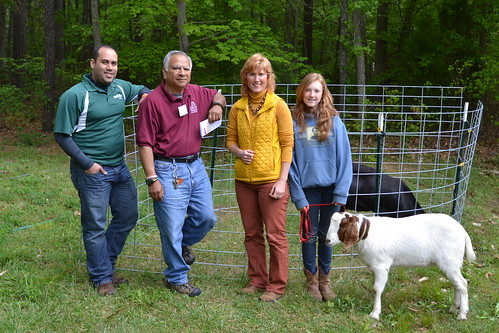By Mary Bowen
Owner, Green Goats
It is easy to see that our roadsides, open fields, woodlands and backyards are becoming overrun with invasive species and other unwanted vegetation. Machines often can't get to problem areas, humans hands are very labor intensive, and herbicides are dangerous to our waterways, soil, and desired vegetation, not to mention animals and humans.
If left alone, invasive plants take over our woodlands, strangling valuable trees and threatening important diversity. Open grasslands and neighborhood backyards become overrun, creating a loss in farming productivity, habitat for birds and other wildlife, and enjoyment of outdoor space.

(L-R) Jorge Rodriquez, Nelson Escobar, Mary Bowen, and Jacqueline Bowen
Owner, Green Goats
It is easy to see that our roadsides, open fields, woodlands and backyards are becoming overrun with invasive species and other unwanted vegetation. Machines often can't get to problem areas, humans hands are very labor intensive, and herbicides are dangerous to our waterways, soil, and desired vegetation, not to mention animals and humans.
If left alone, invasive plants take over our woodlands, strangling valuable trees and threatening important diversity. Open grasslands and neighborhood backyards become overrun, creating a loss in farming productivity, habitat for birds and other wildlife, and enjoyment of outdoor space.

(L-R) Jorge Rodriquez, Nelson Escobar, Mary Bowen, and Jacqueline Bowen
When it comes to clearing unwanted vegetation, goats can provide an ideal alternative to machines and herbicides. They graze in places that mowers can't reach and humans don't want to go (yes, they love Poison Ivy). In fact, goats eat a wide range of unwanted vegetation, which on the East Coast include Kudzu, Oriental Bittersweet, Ailanthus, Multiflora Rose, Japanese Honeysuckle, Mile-A-Minute and much much more.
Goat Grazing Facts:
- Goats have been used by the U.S. Fish and Wildlife Service, the Bureau of Reclamation, the Bureau of Land Management, and the U.S. Forest Service. State, county and city contractors (such as the city of Seattle) have also used goats for weed and invasive species control.
- Goats love broad leafed material, which means brush and invading field vegetation are consumed. But they don't prefer grass, so it is left to flourish.
No comments:
Post a Comment